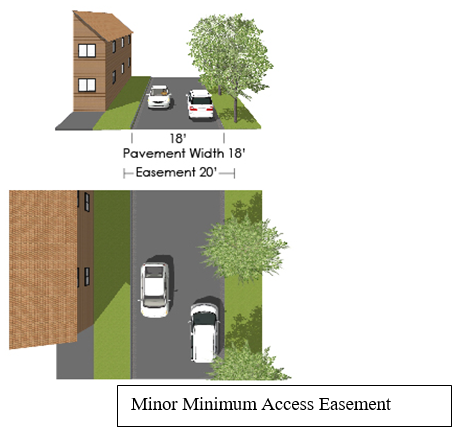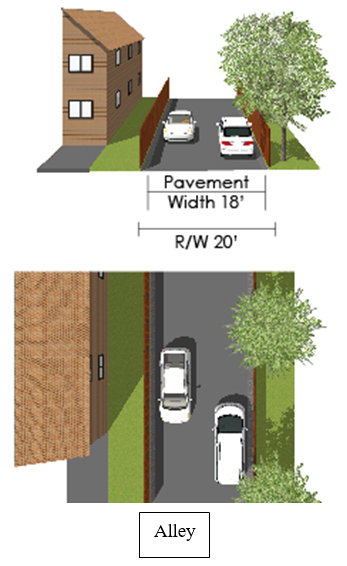10.430A Non-Street Alternatives.
(1) Minimum Access Easements, General. A Minimum Access Easement is an easement containing a shared driveway having the sole function of providing direct access to immediately adjacent residentially zoned land. There are two types of Minimum Access Easements - Minor and Major. Minimum Access Easements differ from residential lanes and public streets in that they are privately maintained.
Special Note:
(i) Public Utility Easements (PUE), when required, may be underneath the pavement of a minimum access easement.
The associated descriptions and cross-sections can be seen below.
(a) Minor Minimum Access Easement. A minor minimum access easement is an easement containing a shared driveway upon which a minimum of two and maximum of three dwelling units (not including accessory dwelling units – ADU’s) take access. A minor minimum access easement must meet the minimum driveway turnaround standards in Section 10.550(2). Minor minimum access easements are permitted subject to Section 10.450. A minor minimum access easement does not have sidewalks or planter strips. No parking is permitted on a minor minimum access easement. A minor minimum access easement is considered a street for purposes of meeting lot frontage requirements, and for setback purposes. Therefore, a minor minimum access easement creates street side yards and corner lots. A minor minimum access easement does not create a through lot.

(b) Major Minimum Access Easement. An easement containing a shared driveway having the sole function of providing direct access to immediately adjacent residentially zoned land, and upon which a minimum of four and maximum of eight dwelling units (not including accessory dwelling units – ADU’s) take access. A major minimum access easement must meet the minimum driveway turnaround standards in Section 10.550(2). Parking is allowed on one side of a major minimum access easement except in dedicated fire department turn-around areas. Major minimum access easements are permitted subject to Section 10.450. A major minimum access easement is considered a street for purposes of meeting lot frontage requirements, and for setback purposes. Therefore, a major minimum access easement creates street side yards and corner lots. A major minimum access easement does not create a through lot.

(2) Alley.
(a) Private alley: A private right-of-way, that is not a street, designed for primary or secondary means of access to abutting property, and which may or may not provide passage through blocks from street to street. Parcels abutting a private alley must also front on a street as defined herein, but not necessarily take primary motor vehicle access from a street.
(b) Public alley: A public right-of-way, that is not a street, designed for primary or secondary means of access to abutting property, and with passage from street to street. Parcels abutting an alley must also front on a street as defined herein, but not necessarily take primary motor vehicle access from a street.
(c) Standards: Alleys shall have a minimum width of twenty feet (20’), with a curb radius of not less than fifteen feet (15’) at an intersection with a street. Parking within an alley is only permitted subject to a permit issued for service vehicles pursuant to Section 6.340. If an existing alley is unpaved and a property owner wants to develop their property and use the alley for access, and this results in an increase in the average daily trips (ADTs) in the alley, then the property owner shall pave the alley from their property to the nearest paved intersecting street.
